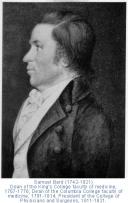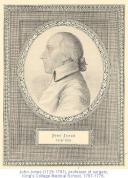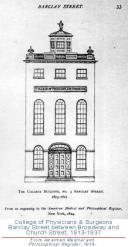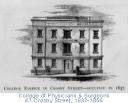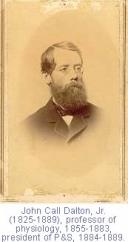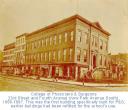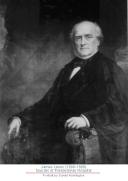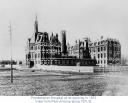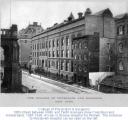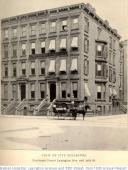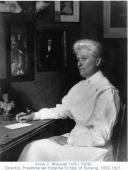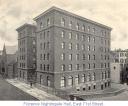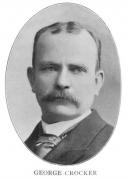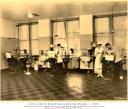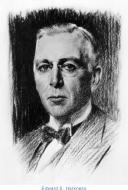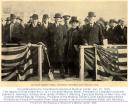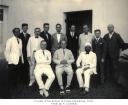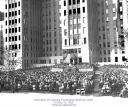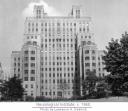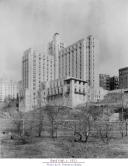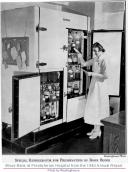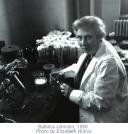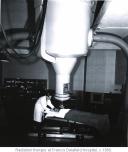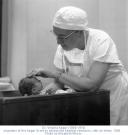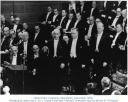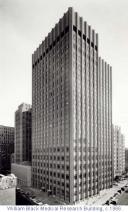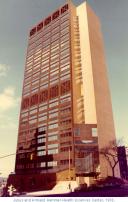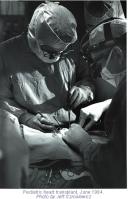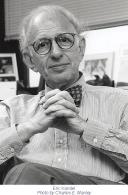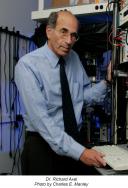The Health Sciences at Columbia University: A Timeline
King's College, chartered by George II, opens as the first institution of higher learning in the Colony of New York
King's College establishes a medical school, the first in New York and only the second in the Thirteen Colonies.
King's awards two BA degrees in medicine at the first commencement of the medical school. In his address to the graduates, Dean Samuel Bard calls for the establishment of what will become New York Hospital.
King's College awards first M.D. degree in the Colonies to Robert Tucker
New York Hospital, the second in the Colonies after the Pennsylvania Hospital, receives charter from King George III.
King's College faculty member John Jones publishes Plain Concise Practical Remarks on the Treatment of Wounds and Fractures, the first surgical text written by an American to be published in North America.
King's College closes due to the American Revolution
King's reopens as Columbia College
Columbia revives the medical school with Samuel Bard as Dean.
New York Hospital opens in buildings on Broadway between what are now Duane and Worth Streets.
The College of the Physicians and Surgeons (P&S) founded by charter from the New York State Board of Regents in response to a petition from the Medical Society of the County of New York.
Samuel Bard becomes President of P&S, a position he retains until his death in 1821.
A new charter from the Regents vests governance of P&S in a 25 member Board of Trustees, effectively ending control of the school by the Medical Society.
After several previous short-lived locations, P&S moves to Barclay Street near City Hall, where it remains for almost 25 years.
After years of decline the Columbia College medical school merges into the College of Physicians and Surgeons.
A dispute over the composition of the Board of Trustees leads to the resignation of almost the entire faculty of P&S.
P&S appoints John Call Dalton, Jr. as first full-time professor of physiology at an American medical school
P&S severs its relationship with the Board of Regents and forges a nominal connection with Columbia, though the school still retains its independence.
Presbyterian Hospital founded by philanthropist and book collector James Lenox. The hospital is to be open to all "without regard to race, creed, or color."
Formal opening of Presbyterian Hospital, October 10, located on a site bounded by Madison and Park Avenues, 70th and 71st Streets.
P&S assumes control of the First Division at Bellevue Hospital.
William Henry Vanderbilt (1821-1885) donates land on 59th Street between Ninth and Tenth Avenues (now Columbus and Amsterdam) and $300,000 for a new building for the College of Physicians and Surgeons, making this the largest gift to a medical school up to that time.
Vanderbilt family members give funds to establish the Sloane Hospital for Women and the Vanderbilt Clinic on the new P&S campus.
Dedication of the new building of the College of Physicians and Surgeons, Sept. 29. Sloane Hospital and the Vanderbilt Clinic inaugurated, Dec. 19.
Babies Hospital (now Morgan Stanley Children's Hospital of New York) founded by five women to provide "medical and surgical aid and nursing for sick babies." The hospital is soon located at Lexington Avenue and 55th Street.
P&S extends course of study to three years.
P&S completely merges with Columbia.
The Presbyterian Hospital of Nursing, predecessor of the Columbia University School of Nursing, opens with Anna C. Maxwell as its first Director.
P&S adopts a four-year course of study.
Florence Nightingale Hall, first home of the Presbyterian Hospital School of Nursing, opens on East 71st Street.
School of Nursing inaugurates a visiting nurse service, precursor to the Presbyterian Hospital Social Service Department.
George Crocker, a Western railroad millionaire, donates $50,000 to Columbia for cancer research. His gift inaugurates the formal study of the disease at Columbia. Upon his death the following year he bequeaths an additional $1.6 million to the university for the same purpose.
Travis Johnson is first acknowledged African American to graduate from the College of Physicians and Surgeons.
Neurological Institute of New York opens as the country's first hospital and research center devoted solely to neurological disorders.
First Agreement of Alliance between Columbia University and Presbyterian Hospital. Philanthropist Edward S. Harkness provides $1 million to facilitate ot the union.
The School of Dentistry opens. In 1923 the new dental school absorbs the College of Dental and Oral Surgery of New York and is renamed the School of Dental and Oral Surgery.
P&S admits women for the first time.
First graduating class of the Dental Hygiene Program of SDOS.
Presbyterian physicians and nurses serve in US Army Base Hospital No. 2 in France.
P&S Dean William Darrach's Memorandum on the School of Medicine outlines possible operating plan for a Columbia-Presbyterian alliance; it breaks deadlock between university and hospital.
Second Agreement of Alliance between Columbia University and Presbyterian Hospital paves way for construction of a "medical center."
Edward S. Harkness and his mother, Mrs. Stephen Harkness, donate 22 acres in Washington Heights to Columbia University and Presbyterian Hospital as the site for the new Medical Center.
Establishment of the DeLamar Institute of Public Health, predecessor of the Mailman School of Public Health. Haven Emerson is first Director.
The School of Tropical Medicine, a joint venture of Columbia University and the University of Puerto Rico, opens in San Juan. It remains Columbia's center for the study of tropical diseases until 1948.
Columbia-Presbyterian Medical Center, the world's first medical center to combine complete facilities for patient care, medical education and research in a single complex, is dedicated on Oct 12 in Washington Heights. Joining the Center are the Vanderbilt Clinic and Sloane Hospital for Women.
Neurological Institute of New York (March) and Babies Hospital (June) open their new buildings at the Columbia-Presbyterian Medical Center.
New York State Psychiatric Institute opens at the Medical Center (December)
School of Dental and Oral Surgery Associate Dean Arthur Rowe and faculty member Paul Wiberg are murdered by a deranged handyman at the Medical Center, Dec. 12.
Presbyterian Hospital School of Nursing becomes Department of Nursing of Columbia University.
Dr. Charles R. Drew receives his Doctor of Medical Science degree from Columbia University for his thesis "Banked Blood: A Study in Blood Preservation," based on his work with Dr. John Scudder in the Presbyterian Hospital Blood Bank. He is the first African American to receive this degree at Columbia.
Medical Center physicians and nurses serve in the U.S. Army's Second General Hospital, first in Britain and then, after D-Day, in France.
Bacitracin is discovered by P&S laboratory supervisor Balbina Johnson. Under the supervision of professor of surgery Frank L. Meleney, it becomes one of the most useful of the early antibiotic drugs.
Columbia University Center for Psychoanalytic Training and Research established as the world's first university-based psychoanalytic institute. First classes in January, 1945.
Mary Imogene Bassett Hospital in Cooperstown, NY, becomes the first P&S teaching affiliate outside New York City.
New York Orthopaedic Hospital moves to the Medical Center after affiliating with Presbyterian Hospital in 1945.
Francis Delafield Hospital, a municipal hospital for cancer patients staffed by Columbia University faculty, opens adjacent to the Medical Center. It closes in 1975.
Professor of Anesthesiology Virginia Apgar (P&S '33) publishes her 10 point score for assessing the condition of newborns, now called the Apgar Score.
P&S faculty members André F. Cournand and Dickinson W. Richards, along with German scientist Werner Forssmann, receive the Nobel Prize in Medicine for their work on cardiac catheterization.
School of Nursing awards country's first master's degree in a clinical nursing speciality.
Dedication of Alumni Auditorium.
School of Public Health is first in the US to offer a graduate degree in sociomedical science, an innovative, multidisciplinary approach to the study of health and medicine.
Opening of the Hammer Health Sciences Center, housing the Augustus C. Long Health Sciences Library as well as classrooms and laboratories.
Columbia's first successful pediatric heart transplant is performed by Eric Rose, MD, June 9.
College of Physicians and Surgeons holds a White Coat ceremony for the incoming Class of 1997, among the first ever at a medical school, August 20.
Mary Woodard Lasker Building, first structure of the Audubon Biomedical Science and Technology Park, opens on a campus adjacent to the Medical Center.
Merger of New York Hospital and Presbyterian Hospital to form New York-Presbyterian Hospital, Dec. 31.
The School of Public Health renamed the Mailman School in recognition of a $33 million gift from the Mailman Foundation, the largest gift to a public health school up to that time.
Completetion of new home for the New York State Psychiatric Institute on Riverside Drive.
P&S faculty member Eric Kandel wins the Nobel Prize in Medicine for his work on the molecular basis of memory.
Opening of Morgan Stanley Children's Hospital of New York.
Columbia University Health Sciences Division changes its name to Columbia University Medical Center.
Richard Axel, P&S faculty member, is awarded the Nobel Prize in Medicine for his work in determining the genes that govern the sense of smell.
School of Dental & Oral Surgery changes its name to the College of Dental Medicine.
Mailman School of Public Health building (originally the New York State Psychiatric Institute) named in honor of the School’s long-time Dean, Allan Rosenfield.
Dedication of Roy and Diana Vagelos Education Center, June 9.
The Columbia University Medical Center is renamed the Columbia University Irving Medical Center in honor of Herbert and Florence Irving's great generosity to Columbia University and New York-Presbyterian Hospital, September.
Dedication of the School of Nursing building, West 168th St. and Audubon Ave., June 8.
Joachim Frank, professor of biochemistry and molecular biophysics at CUIMC and professor of biological sciences at the Morningside Heights campus, is awarded the Nobel Prize in Chemistry for his work in developing cryo-electron microscopy to construct three-dimensional images of molecules.
Roy Vagelos (P&S 1954) and his wife, Diana (Barnard, 1955) donate $250 million to the medical school, $150 million of which endows a fund to help Columbia eliminate student loans for medical students who qualify for financial aid. The medical school is renamed the Roy and Diana Vagelos College of Physicians and Surgeons in honor of their generosity, December 4.
Katrina Armstrong becomes Dean of the Faculties of Health Sciences and the Vagelos College of Physicians and Surgeons and Chief Executive Officer, Columbia University Irving Medical Center - the first woman to hold these posts.
